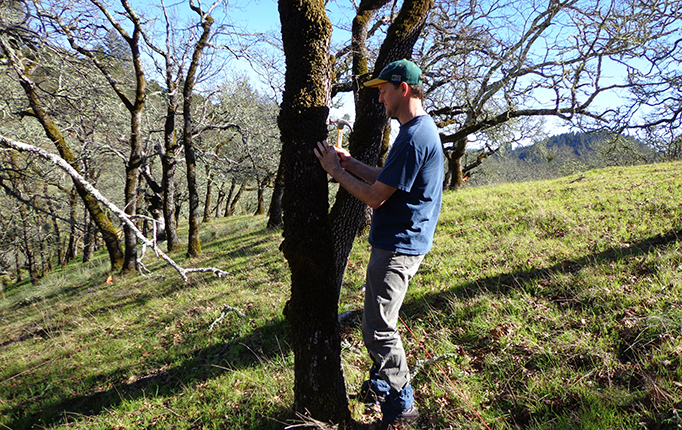
Lead author David Ackerly tags an Oregon oak, one of the species that primarily occupies cooler, north-facing locations, at Pepperwood Preserve. Photo by Michelle Halbur.
As the climate warms, researchers seek to understand how climate and topography influence plant and animal distributions. By analyzing species distributions and their environmental determinants, scientists can better formulate management goals and conservation strategies for the future.
In a study published in a 100-page special issue of Frontiers in Ecology and the Environment today, Berkeley researchers discuss how various species in cooler locations may be nearing the brink of habitable geographic ranges in California. The authors find that adaptations to cooler climates make many plants and animals especially vulnerable as the climate grows warmer and drier, causing shifts in the abiotic conditions of habitats.
“Intuitively, we think that cool locations in the landscape may be protected from climate change, but our work shows that the species in these locations may actually be the most vulnerable,” says David Ackerly, dean of the College and lead author of the study.
Landscape features and orientation—for example, north- and south-facing slopes—create microclimates that support distinct plant communities. The study results indicate that the composition of tree communities will shift to favor more dry and warm-adapted species—a trend called “thermophilization” now occurring across many plant communities globally.

Coauthor Meagan Oldfather measures saplings in a research plot at Pepperwood Preserve. Photo by Michelle Halbur.
At Pepperwood Preserve, a biodiversity hotspot located in Northern California’s Sonoma County, the group analyzed 12 focal tree species at dry and wet edges of the habitat range, accounting for the south versus northward exposure at each location. A conceptual framework was designed to evaluate how regional climate and the local effects of elevation, topography, and water availability impact species distributions, allowing the authors to make predictions based on future climate scenarios.
Within species, populations tend to occupy cool, pole-facing slopes in warm regions and warm, equator-facing slopes in cool regions. Tree species on the cool, pole-facing slopes tend to occupy cooler distributions at a regional scale as well as cooler geographic distributions. The authors find that “species occupying cooler sites within a landscape are projected to decline in response to warmer/drier future climates.”
Physically heterogeneous landscapes—environments that exhibit a wide variety of abiotic conditions within close proximity—are particularly important for maintaining biological diversity. Such landscapes support habitat across many niches and functional strategies of species while also minimizing the distances species must move for suitable conditions. Moreover, these landscapes can harbor species that migrate from outside areas, in which conditions have grown inhospitable.
Changes in species distribution due to climate change will present significant challenges for ecosystem management and conservation. “As the climate changes, plants and animals will respond, some becoming more common and some less,” says Ackerly. “We need to decide what role to play in these changes. Are we trying to prevent change, to conserve current biodiversity? Or maybe we will facilitate these changes, to ensure that nature can keep pace with the changing conditions.”
The special issue of Frontiers covers climate change refugia, or the areas relatively buffered from current climate change that shelter valued wildlife, ecosystems, and other natural resources. The special issue includes research on climate refugia related to fish, wildlife, rivers and wetlands, mountains, and forests, as well as various conceptual advances and successful applications of refugia maps and management data.
Ackerly conducted the study in collaboration with Matthew M. Kling and Prahlad Papper in the UC Berkeley Department of Integrative Biology, as well as researchers at Sonoma State University, University of Colorado, Boulder, and the U.S. Geological Survey. Read the full study on the Ecological Society of America website.
